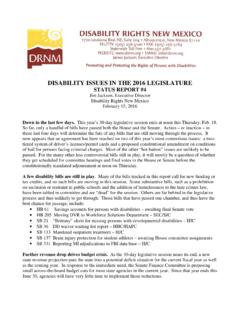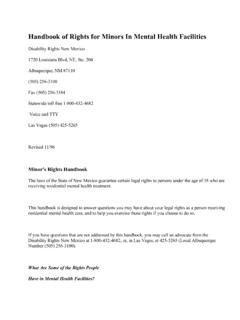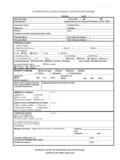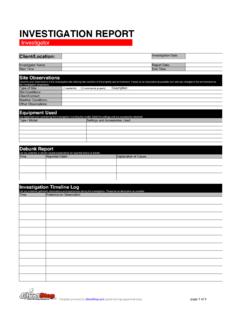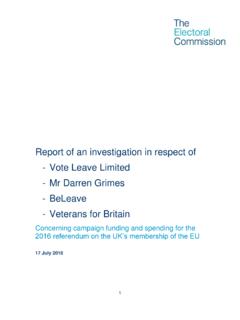Transcription of Preliminary Investigation Report Summary of …
1 1 Preliminary Investigation Report Disability Rights New Mexico Strategic Behavioral Health dba Peak Behavioral Health December 8, 2015 Summary of Contents I. Introduction II. Summary of Findings/Findings of Fact III. Structure of Investigation /Methodology IV. Review of Documentary Evidence and Statutory/Regulatory Authority V. Conclusions and Recommendations VI. Appendix 2 I. Introduction DRNM, an independent non-profit organization, has been the state s designated protection and advocacy (P&A) agency since 1979. Congress found that people with mental illness are vulnerable to abuse and serious injury and created the P&A agencies to protect and promote the rights of people with disabilities, authorizing them to investigate incidents of abuse and neglect of individuals with mental illness if the incidents are reported to the system or if there is probable cause to believe that the incidents occurred.
2 42 USC 10801 (b). DRNM is authorized to conduct investigations in any facility in New Mexico providing care or treatment 42 USC 10802, 42 USC 10805 (a)(1)(A). In January 2014, Disability Rights New Mexico (DRNM) began receiving consumer complaints regarding Strategic Behavioral Health dba Peak Behavioral Health in Santa Teresa, NM. The Peak, as it is commonly called, is a 119-bed facility located in a rural area in southern New Mexico near El Paso, TX. The complaints came directly from residents in the adolescent Residential Treatment Center (RTC) and covered a variety of concerns regarding the use of restraints: unnecessary restraints, improper restraints that resulted in injuries, and the use of chemical restraint.
3 Additionally, DRNM received grievances from residents who were forced to wear paper scrubs and were banned from going outside or to school. In response to these concerns, DRNM staff began visits to monitor the Peak s adolescent RTC in February 2014. Through monitoring visits, DRNM found probable cause to believe that individual residents at the Peak may have been subject to abuse or neglect. Residents reported painful restraints that resulted in bruises, sprained or hurt arms, as well as incidents of being thrown against walls and having their faces smashed into door frames and foot boards of beds. Residents also reported verbal abuse by staff, including name-calling and threats of physical 3 harm, as well as a lack of sufficient therapies, not being allowed to use the restroom during the four-hour school day, and not being allowed to call their attorneys, Juvenile Probation Officers (JPOs), or DRNM.
4 Consequently, on February 28, 2014, DRNM sent a probable cause letter to the Peak administration and launched an Investigation of the Peak s RTC units. II. Summary of Findings/Findings of Fact A comprehensive review of incident reports from September 2014-September 2015 reveals data supporting the assertion that Strategic Behavioral Health provided an unsafe environment to residents on the adolescent RTC units at the Peak. DRNM concludes these residents, ages 12-18, were exposed to a pattern and practice of neglect as defined by NMAC CL. (2-4). During the 13-month period of focused document review, DRNM staff found that: 1. There were 80 incidents involving resident-on-resident violence or aggression.
5 2. Numerous injuries resulted from the 80 incidents of resident-on-resident fighting. Types of injuries included a fractured nose, loss of teeth, bleeding and swollen open lips, ecchymosis, a cut requiring stitches, and eye, hand, and ankle injuries requiring X-rays. 3. Peak staff documented six trips to the ER or Urgent Care clinic for injuries incurred from fighting that required medical care beyond the Peak s scope of practice. 4. Law enforcement was called 21 times to the Peak s adolescent RTC during the 13-month period. 5. Four residents were charged with Class III Battery for attacking other residents. 6. There were 53 incidents involving resident suicide attempts or self-harm.
6 7. There were 23 incidents of resident elopement from the facility. 8. Five residents made allegations of a sexual nature against other residents. 4 9. One resident was injured while being restrained in a chokehold by a Mental Health Technician (MHT). III. Structure of Investigation /Methodology In February 2014, DRNM staff began monitoring activities to determine the scope of the Investigation . These activities included: 1. frequent visits to the Peak to meet with residents on the adolescent RTC units regarding their concerns, and 2. reviewing incident reports generated by Peak staff, including restraint reports and critical incident reports. The site visits to the Peak s RTC units were conducted by a DRNM Advocate.
7 During the visits, DRNM met with groups of residents on each unit and privately if the residents requested. In addition to educating residents about their rights, she documented resident concerns and presented these issues to Peak administration in person, by phone, and in writing. Over the course of the Investigation , DRNM received monthly copies of incident reports from the Peak. These included both restraint reports and incident reports of a critical nature as determined by Peak staff. The incident reports were reviewed by a DRNM Advocate and Paralegal, who followed up with Ms. Sylvia Huerta-Lopez, Risk Assessment Manager at the Peak, on events that were of a significant nature.
8 In August 2015, DRNM staff observed a significant increase in activity in two particular areas. These areas included: 1) incidents of resident-on-resident violence, and 2) the use of psychotropic medication injections following incidents of physical restraint. The charts below demonstrate the increase in these two activity areas: 5 Incidents of Resident-on-Resident Violence or Aggression per Peak incident reports, Sept. 2014 - Sept. 2015 Month Frequency Sept 2014 2 Oct 2014 1 Nov 2014 7 Dec 2014 9 Jan 2014 6 Feb 2014 4 Mar 2014 4 Apr 2015 3 May 2015 2 June 2015 7 July 2015 16 Aug 2015 15 Sept 2015 4 Year Total 80 6 Use of injections following physical restraints, as recorded by Peak staff on incident reports Sept.
9 2014 - Sept. 2015 Month Number of injections following physical restraints Sep 2014 6 Oct 2014 5 Nov 2014 17 Dec 2014 15 Jan 2015 3 Feb 2015 2 Mar 2015 6 Apr 2015 3 May 2015 7 Jun 2015 2 Jul 2015 5 Aug 2015 19 Sep 2015 15 Year Total: 105 In response to these trends, DRNM staff performed a comprehensive review of the data collected from the Peak between September 2014 and September 2015. 7 Document Review Protocol During the 13-month period of focused review, DRNM received 316 incident reports from the Peak. Of the 316 reports received, 245 were labeled as restraint incident reports while the remaining 71 were classified by the Peak as critical incidents. With resident safety concerns in mind, DRNM staff separated both categories of incidents into six further classifications: 1.
10 Resident-on-resident violence or aggression 2. Attempted resident-on-resident violence or aggression 3. Resident-on-staff violence or aggression 4. Resident self-harm, including suicide attempts 5. Resident elopement 6. Other significant events involving resident safety. A summarizing description of each of the 316 incident reports was entered by a DRNM Advocate into a database. This database provided the framework for DRNM staff to analyze and evaluate the incident reports collected from September 2014-September 2015 by frequency and type. Please see Appendix item 1 for a comprehensive chart detailing the Peak Incident Reports submitted to DRNM between September 2014 and September 2015.
